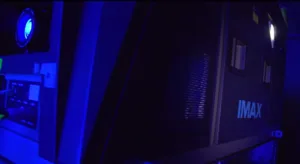About two years ago, IMax launched a laser projector solution call GT that is a dual laser solution for the large screens in an IMax theater. At CinemaCon, they announced the next generation of this laser-based IMax solution, including a new audio system. This was not on display at CinemaCon, but it is being shown in a theater in Los Angeles, which we plan to visit in a few weeks. IMax CTO Brian Bonnick told us that at least 26 exhibitors have now seen a demo in LA and the result – over 150 systems have been ordered just from two major exhibitor chains so far: AMC and Cineworld.
Bonnick told me that the new projector was developed to offer a lower cost solution but without sacrificing image quality. It retains the same basic architecture which includes IP developed by Kodak and a prism-less 3-DMD 4K resolution architecture. But, the system now can be realized in a single projector to cover screens greater than 80’ (24.4m) wide in a 1:43 aspect ratio.
“The big reason for the dual projector system with the GT is the need to deliver high enough brightness in 3D,” explained Bonnick. “The new system does this in a single projector with a dual lens design. I can’t say much about what the dual lens does, but it is more than just a 3D solution,” noted Bonnick. “We have improved the contrast to over 10,000:1 sequential and really improved the sharpness of the image. Brightness remains about the same – 22 fL (75 cd/m²) in 2D or 3D.” The 3D is now based on circularly polarized glasses.
Bonnick noted that they have gotten away from discussing specs outside of the technical community as numbers can get compared without understanding content. For example, contrast in a theater is often dominated by the room contrast (perhaps 20K:1). That means a projector with better contrast is not really seen as the total contrast is a sum of the inverse of the contrast components.
Bonnick did reveal they have also improved the intraframe contrast, which is a more relevant measure of the actual contrast that is visible in a scene. One method is a checkerboard pattern that is like an ANSI contrast, but Bonnick said they have other methods to determine the “bleed”. By this he means light leakage from a bright pixel into a dark pixel. This is like measuring the halo around bright objects in an HDR display. He gave no indication as to how these projectors stack up in this area, but certainly suggested the new one performs very well.
Projectors Now Sealed
Besides the dual lens design, another innovation was a totally sealed environment within the projector. Since the light and therefore heat on each DMD varies based on the scene content, there can be a differential in how the DMD responds to this load. This can cause slight misconvergence of the red, green and blue light paths, which are more obvious on a big IMax screen. By carefully controlling the humidity and thermal environment of each DMD, IMax is able to obtain the incredible sharpness the Bonnick was so proud of.
Also upgraded was the monitoring of the projector and cinema which can be viewed in the Network Operation Center (NOC). This includes a camera that monitors the image on-screen and a microphone to monitor sound.
The audio system will be upgraded as well to a 12-channel solution that include an overhead channel. With the audio pre-processor that tunes the audio to the specific theater, IMax was able to expand the audio sweet spot as well.
Bonnick said they have been working on the solution for two and a half years and a few pilot systems are installed already. They will begin full scale manufacturing soon (presumably with partner Barco) and begin installs by the end of the year. A cost reduction effort will follow soon afterwards (move to molded vs. milled aluminum parts, for example).
Bonnick did not comment on price, but one report suggested the projector could cost $600-$700K. – CC

